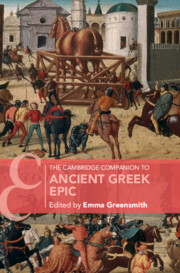Refine search
Actions for selected content:
101 results
4 - Potnia of the Labyrinth, Initiation of the King, and the Triple Sacrifice
-
- Book:
- Myth, Ritual, and Society in Mycenaean Anatolia
- Published online:
- 18 July 2025
- Print publication:
- 07 August 2025, pp 131-161
-
- Chapter
- Export citation
2 - Mycenaean and Vedic Sacrificial Posts
-
- Book:
- Myth, Ritual, and Society in Mycenaean Anatolia
- Published online:
- 18 July 2025
- Print publication:
- 07 August 2025, pp 47-66
-
- Chapter
- Export citation
6 - Nart Saga, Indo-Iranian Twins, and Dioscurias
-
- Book:
- Myth, Ritual, and Society in Mycenaean Anatolia
- Published online:
- 18 July 2025
- Print publication:
- 07 August 2025, pp 194-237
-
- Chapter
- Export citation
7 - Golden Fleeces
-
- Book:
- Myth, Ritual, and Society in Mycenaean Anatolia
- Published online:
- 18 July 2025
- Print publication:
- 07 August 2025, pp 238-272
-
- Chapter
- Export citation
5 - Mitannian and Anatolian Triads
-
- Book:
- Myth, Ritual, and Society in Mycenaean Anatolia
- Published online:
- 18 July 2025
- Print publication:
- 07 August 2025, pp 162-193
-
- Chapter
- Export citation
3 - Mycenaean Leaders in the Context of Indo-European and Indo-Iranian Society and Ritual
-
- Book:
- Myth, Ritual, and Society in Mycenaean Anatolia
- Published online:
- 18 July 2025
- Print publication:
- 07 August 2025, pp 67-130
-
- Chapter
- Export citation
Introduction
-
- Book:
- The Fragmentary Greek Chronicles after Eusebius
- Published online:
- 11 September 2025
- Print publication:
- 24 July 2025, pp 1-58
-
- Chapter
- Export citation
REVIVING PAST POTENTIALS IN CLASSICAL GREEK
-
- Journal:
- The Classical Quarterly , First View
- Published online by Cambridge University Press:
- 09 June 2025, pp. 1-18
-
- Article
-
- You have access
- Open access
- HTML
- Export citation
Language and structure activation explain cross-linguistic influence in bilingual language production: Evidence from within- and across-language priming
-
- Journal:
- Bilingualism: Language and Cognition , First View
- Published online by Cambridge University Press:
- 05 May 2025, pp. 1-15
-
- Article
-
- You have access
- Open access
- HTML
- Export citation
Chapter 7 - Ancient Philosophy
- from Part II - Intellectual, Cultural, and Political Contexts
-
-
- Book:
- Percy Shelley in Context
- Published online:
- 17 April 2025
- Print publication:
- 24 April 2025, pp 51-58
-
- Chapter
- Export citation
Iliad Translations in the Undergraduate Classroom
-
- Journal:
- Journal of Classics Teaching / Volume 26 / Issue 52 / Autumn 2025
- Published online by Cambridge University Press:
- 21 February 2025, pp. 151-157
-
- Article
-
- You have access
- Open access
- HTML
- Export citation
1 - Pre-Christian Marriage Ritual in the Mediterranean World
- from Part I - The Christianization of Ancient Marriage Ritual
-
- Book:
- Marriage in Byzantium
- Published online:
- 01 May 2025
- Print publication:
- 23 January 2025, pp 13-48
-
- Chapter
- Export citation
Chapter 7 - Classics
- from Part II - Aesthetic and Cultural Contexts
-
-
- Book:
- Gerard Manley Hopkins in Context
- Published online:
- 16 January 2025
- Print publication:
- 16 January 2025, pp 60-68
-
- Chapter
- Export citation

The Cambridge Companion to Ancient Greek Epic
-
- Published online:
- 04 December 2024
- Print publication:
- 28 November 2024
16 - “Peace Be upon You”: Arabic Greetings in Greek and Coptic Letters Written by Christians in Early Islamic Egypt
- from Part III - Communities
-
-
- Book:
- Mechanisms of Social Dependency in the Early Islamic Empire
- Published online:
- 06 December 2024
- Print publication:
- 28 November 2024, pp 466-480
-
- Chapter
-
- You have access
- Open access
- Export citation
Introduction
-
-
- Book:
- Texts and Intertexts in Archaic and Classical Greece
- Published online:
- 14 November 2024
- Print publication:
- 21 November 2024, pp 1-28
-
- Chapter
- Export citation
Chapter 18 - Dictionaries in Religious History and Biblical Interpretation
- from Part III - Dictionaries and Ideology
-
-
- Book:
- The Cambridge Handbook of the Dictionary
- Published online:
- 19 October 2024
- Print publication:
- 31 October 2024, pp 361-384
-
- Chapter
- Export citation
Chapter 9 - Hannibal and Scipio Meet and Fight at Last
-
- Book:
- Hannibal and Scipio
- Published online:
- 05 September 2024
- Print publication:
- 26 September 2024, pp 207-221
-
- Chapter
- Export citation
Chapter 15 - Greek and Roman Art
- from Part III - Art
-
-
- Book:
- Goethe in Context
- Published online:
- 16 May 2024
- Print publication:
- 23 May 2024, pp 141-149
-
- Chapter
- Export citation
32 - Scripts
- from Part 5 - Sociolinguistic and Geographical Approaches
-
-
- Book:
- The Cambridge Handbook of Slavic Linguistics
- Published online:
- 16 May 2024
- Print publication:
- 23 May 2024, pp 675-696
-
- Chapter
- Export citation
